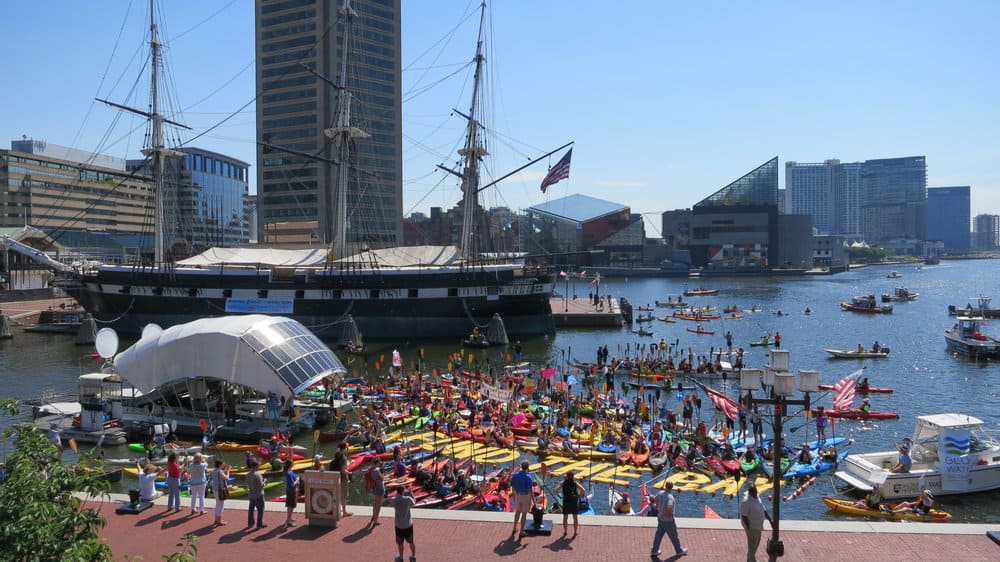Photo by Meg Walburn Viviano
The maritime term flotilla comes from the Spanish word flota, and refers to a fleet of ships, especially small war ships. On Saturday, June 9, small ships of a different kind will invade Baltimore Harbor to wage war on pollution in the harbor and Chesapeake Bay.
The Baltimore Floatilla for a Healthy Harbor is a flotilla of paddlers in kayaks, canoes, and on standup paddleboards, who complete a five-mile course around Charm City’s waterfront. The urban water route begins at Canton Waterfront Park on the southeast side of the Harbor and culminates in a floating rally at Harborplace, next to the USS Constellation, and then doubles back to Canton for a post-paddle shore party with music and food. The experienced paddlers do it all to raise awareness for clean water projects
Adam Lindquist, Director of the Healthy Harbor Initiative for Baltimore’s Waterfront Partnership, puts it this way: “An unloved and unused waterway doesn’t get cleaned up, and the Baltimore Floatilla shows how many people use and love
the harbor.”
This will be the third annual Floatilla, with the most recent rally drawing some 300 paddlers and supporters. It’s a scene that causes a lot of gawking on land.
In 2017, waves of paddlers arrived at the heart of the Inner Harbor where the band Tongue in Cheek played Chesapeake Bay-themed jazz tunes. Even Mr. Trash Wheel, the giant water wheel that collects litter flowing down from the Jones Falls, floated over for the occasion.
One of the paddlers, Canton resident Mary Arthur, said she “just has to” be part of the Floatilla. She’s not afraid of kayaking in the polluted water, and argues that people who are afraid should be even more inclined to support harbor cleanup.
“You’re sketched out about the water? Then DO something about it!” she exclaimed.

Kayakers Mike and Ann Armstrong traveled to Baltimore from Clarksburg, Maryland for the rally. Mike loves to fish various spots on the Bay in his kayak.
“The Chesapeake is such a jewel, there are so many different kinds of fish,” he said. Ann added, “We want to promote funding the Bay because it’s dirty, and we like to use it.”
Last year’s paddle came right on the heels of a White House proposal to defund the Chesapeake Bay cleanup effort. Floating activists clung to every inch of the Inner Harbor’s bulkheads to make a statement about the importance of federal funding for Bay restoration. Leaders from Waterfront Partnership
of Baltimore, Bluewater Baltimore and the Chesapeake Bay Foundation addressed the group:
“I’ve never understood why it is that we have to fight for clean water,” says Will Baker, president of the Chesapeake Bay Foundation.
Bluewater Baltimore executive director Jenn Aiosa urged the crowd, “Take your passion for being out here today to your elected officials.”
Bluewater Baltimore and the Healthy Harbor Initiative have the ambitious goal of making the harbor swimmable by 2020. Lindquist and Aiosa believe there is reason for optimism, and parts of the harbor are getting cleaner. But with millions of gallons of sewage and pollution still reaching the Harbor each year, both leaders admit the rate of improvement would have to get faster for the harbor to be swimmable by 2020.
In the meantime, the Floatilla of war ships will continue to take up their paddles to fight for cleaner water.



